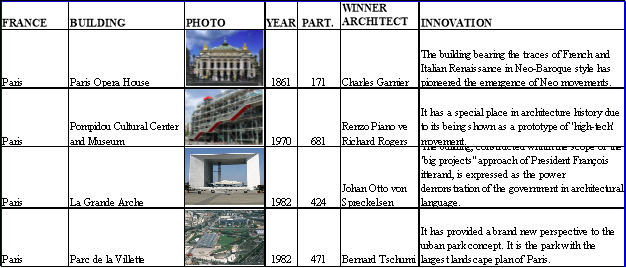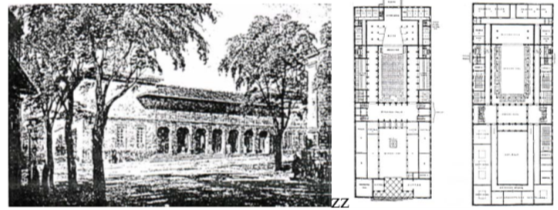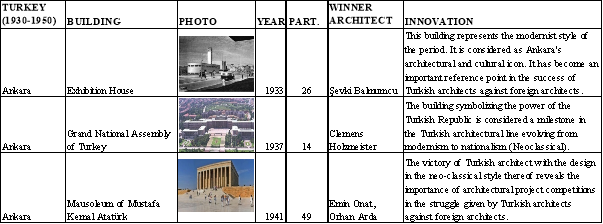How to Cite this Article:
Sirel, O., SIREL, A., & TURSOY, B. (2019). Effects of Architectural and Urban Design Project Competitions on Built Environment and New Discourses Brought Thereby. Journal of Contemporary Urban Affairs, 3(1), 109-120. https://doi.org/10.25034/ijcua.2018.4688
Journal Of Contemporary Urban Affairs
2019, Volume 3, Number 1, pages 109–120
Effects of Architectural and Urban Design Project Competitions on Built Environment and New Discourses Brought Thereby
* M.Sc OSMAN UMIT SIREL 1, Dr. AYSE SIREL 2, M.Sc BURAK TURSOY 3
1 Bahçeşehir University, Faculty of Architecture and Design, Istanbul, Turkey
2 İstanbul Aydın University, Faculty of Architecture and Design, Istanbul, Turkey
3Eastern Mediterranean University, Faculty of Architecture, Famagusta, Cyprus
1Email: umitsirel@yahoo.com 2Email: aysesirel@aydin.edu.tr 3Email: buraktursoy@gmail.com
*Corresponding Author:
Bahçeşehir University, Faculty of Architecture and Design, Istanbul, Turkey.
E-mail address: umitsirel@yahoo.com
A R T I C L E I N F O:
Article history:
Received 08 January 2018
Accepted 13 April 2018
Available online 03 July 2018
Keywords:
Competition;
Culture of Competition;
Architectural Design;
Built Environment;
Urban Design.
A B S T R A C T
Competition system is considered to be the most objective project selection method in a country’s architectural and urbanism organization and is a mechanism which promotes professional creativity. Both national and international competitions have a significant potential in terms of providing knowledge and accumulation to contemporary architecture history. It is stated by the studies conducted on design competitions that while competitions contribute to the architecture environment of the country where they are held, they also provide opportunity for monitoring the architecture and accordingly changing discourse of the environment. The aim of competitions is to obtain "the best project" for a building or building group or a specific area, designs of which are predetermined. Furthermore, it has been stated that competitions are one of the methods to obtain qualified buildings and environments in Turkey, there are problems in their being sufficiently developing, leading and raising awareness. The reasons why there are still a few qualified buildings (besides exceptions) have been stressed. Recommendations as to institutions organizing design competitions, creation of specifications for design competitions and establishment of jury in design competitions have been offered for eliminating issues in design competitions.
JOURNAL OF CONTEMPORARY URBAN AFFAIRS (2019), 3(1), 109-120. https://doi.org/10.25034/ijcua.2018.4688
www.ijcua.com
Copyright © 2018 Journal Of Contemporary Urban Affairs. All rights reserved.
1. Introduction
Design competitions, results of which are anticipated with anxiety, are conducted in numerous countries with an eye to select the best in their disciplines. Both national and international competitions have a significant potential in terms of providing knowledge and accumulation to contemporary architecture history. It is stated by the studies conducted on design competitions that while competitions contribute to the architectural environment of the country where they are held, they also provide opportunity for monitoring the architecture and accordingly changing discourse of the environment. Sure enough, considering the remarkable buildings of the second half of the 20th century, the project competitions and the competition colloquiums as regards the cited buildings are observed to have significant influences on architectural and urban environment in terms of theoretical discussions and innovations.
Objective, nature and achievements of the project competitions are discussed primarily in the study. In this context the buildings which have been built by competitions and which are known as the important examples of the architectural history of Turkey and the world have been examined by taking their periods into consideration. The importance of competition models in the European and Nordic countries where new and different discourses are brought forward, extreme points of design are questioned and criticizing and groundbreaking unique products are revealed are underlined. On the other hand, it has been stated that competitions are one of the methods to obtain qualified buildings and environments in Turkey, there are problems in their being sufficiently developing, leading and raising awareness. Recommendations as to institutions organizing design competitions, creation of specifications for design competitions and establishment of jury in design competitions have been offered for eliminating issues in design competitions.
1. Objective of the study
The objective of this study is to determine the effects of new ideas, technologies and talents brought forward through the architectural and urban design project competitions on the built environment. Contributions of competitions made in the U.S.A., some European countries and Turkey and the applications obtained by such competitions on architecture and urban environment obtained within this framework have been explained.
2. Architectural and Urban Design Project Competitions and Achievements
Different definitions of project competitions are available in different sources. According to the "International Union of Architect / UIA" regulations which are valid in international projects, competitions are held in order to find the best solution among many designs and ensure that the designer is included in the process during the application phase of the project (UIA, 2000). SAFA, the Finnish Architects Association, which is highly experienced in competitions, defines competition as a method of obtaining the most important projects which is focused on quality and developing the fine skills of the profession and which contributes to the beauty of the built environment for a democratic society. Competitions are regarded as opportunities for professionals to train themselves more, test new theories and improve their skills. It is stated that competitions provide learning experience to participants of the competition during the competition process by virtue of evaluation alternatives from different points (URL 1). The concept of competition in Turkey is defined as "an organization necessary for the realization of a subject related to architecture, landscape architecture, engineering, urban design projects, urban and regional planning and fine art works ... " (Regulation on Architecture, Landscape Architecture, Engineering, Urban Design Projects, Urban and Regional Planning and Fine Arts Competitions", 2004).
As it can be understood from the definitions, a competition is aimed to obtain the "best project" for a specified building or built environment or for a specific area. Competition system is the most objective system in selection of architectural, urban design and urban planning projects. It is a mechanism which establishes the society’s connection with architecture and which promotes professional creativity. At the same time, competitions are important tools for drawing attention to how effective the role of designers (architect, urban designer, landscape architect) is in the development of society (Rönn, 2009).
A competition is a platform where a tool and new ideas are produced, new arguments are put forward and the most extreme ideas are questioned in order to obtain a design. The achievements of competitions, in this context, can be summarized as follows:
-
Encouraging fine arts and architecture,
-
Selection of a qualified project in line with the architectural and urbanism approach of our day,
-
Contribution to the development of urban texture by virtue of application of qualified projects,
-
Contributing to the development of the architectural and urban environment thanks to their educational and developmental aspects,
-
Encouraging designers for new quests and researches and educating them,
-
Ensuring designers to be able to see the projects together and have a chance to compare them,
-
To bring different architectural-urbanism approaches together on a common platform by virtue of international competitions and cause designers to think in universal dimensions,
-
Determination of talented young designers,
-
Creating new business areas by giving the chance of application to the winning designers and
-
Assuming an important role in the development of architecture and urbanism in the country thanks to the idea archive that created thereby as well as its means of accumulating knowledge to new generations.
4. Design Competitions in the World and Turkey and New Discourses Brought Thereby
4.1 Design Competitions in the World and Important Buildings
The first registered competition in history which has directed the world architecture was carried out for Acropolis which was elected and applied by the people of Athens to symbolize the end of Persian wars in 448 B.C. This is followed by the competition organized in 1419 for designing the dome of the Cathedral of Florence. The competition which Filippo Brunelleschi won is considered as the first product of the Renaissance (Şentek, 2013) The approach of obtaining the best project by virtue of competitions has been often practiced in the U.S.A. and Europe as from the 19th century and there are numerous buildings constructed by means of competition. The rate of constructing buildings by means of competitions in Europe is more widespread compared to the United States. This fact is based on two factors. The first factor is the different approach to architecture while the second one is the nature of the institutions which conduct the contests. In the United States, the architectural bureaus consider the issue as being large capitalist investor organizations, while artistic approaches are applied by small-scale architectural bureaus operating in Europe (Akansel, 2003). Another factor is "the European Union's European Competition Regulations" is. According to the regulation which has came into force in 1992, it is obligatory to obtain projects of large-cost public investments by virtue of competitions. Furthermore, the manual prepared by American Institute of Architects (AIA) on architectural design competitions directs employers to competition while referring to the neutral position of AIA as a professional organization during the process at the same time (AIA, 2011; Şentek, 2013), (URL 2).
Germany is an exemplary country in terms of competitions. Competition rules were set in 1867 in Germany. Projects of all public buildings are obtained through competitions thanks to the tradition of competitions dating back to 1870s. "German Competition Principles and Directives Applied for the Fields of Physical Planning, Urbanism and Architecture/GRW 1995" defines competition as; "not only the best design concept but also the project owner who will implemented the project by developing at a later stage is obtained by virtue of intensive works performed by transparent methods through an impartial jury" (Özbay, 2003).The fact that nearly 35 competitions are organized each month in Germany is an important indicator in determining the level of urbanism and architecture, and professional development of the country. Wettbewerbe Aktuell (WA) publishing competition projects periodically since 1980, is Germany's most prestigious competition magazine (URL 3).
There are also laws in France and Spain to build all public buildings by virtue of design competitions. The giant projects obtained by national and international competitions in France draws attention of both French and the world people. Competition rules were set in 1872 in England through the Royal Institute of British Architects (RIBA). The Finnish Architects Union (SAFA), founded in Finland in 1919, created the "Board of Competitions" in 1947 (URL 4). The mentioned board is obliged to submit the most accurate information to the competitors and write the specifications. In Finland, the buildings obtained through competitions held by the state as well as private firms, are among the important world examples. It can be seen that the rules to be applied in design competitions were set by the regulations in the 19th century in European and Nordic countries as well as in America. The projects selected and applied by virtue of the competition projects have created a database reflecting the architectural and urbanism approach of that period they have been made in (idea archive) and have played a significant role in the development of those country's architecture and urbanism.
The selected buildings obtained through competitions and known as important examples of architecture and urbanism history by the innovations they have brought and the countries where they are located in are mentioned in the following tables (Tables 1 to 5).
Table 1. Selected competition examples from the U.K

Table 2. Selected competition examples from Germany

Table 3. Selected competition examples from France

Table 4. Selected competition examples from Finland

Table 5. Selected competition examples from Austria, Australia and Sweden

Issues such as the conditions in which the designs are prepared, the place of the designs in social, political and cultural contexts specific to that place and the actors of the competitions and significant effects of discussions made on these issues on the architectural and urban environment of the country have been observed in the examined world samples of competition projects.
4.2 Design Competitions and Important Buildings in Turkey
Obtaining architectural projects, through competitions in Turkey, dates back to 1860s. The first competition held in Turkey was the project competition organized in 1867 for the summer residence of the British embassy in Tarabya district (Cezzar, 1991). The competition had to be conducted in the UK because conditions for opening a competition in Turkey were not suitable in that period, however there is no information on whether the winning project was implemented or not. This competition was followed by the Turkish-German Friendship Foundation Competition held in 1916. The project of Bestelmeyer's project from Germany which won the 1st prize in the competition could not be applied due to the outbreak of World War 1 (Figure 1). Paul Bonatz, one of the participants of this competition among other participants such as Martin Elaesser, Teodor Fisher, Hans Poelzig and Bruno Tau (one of the important names of modern architecture), later served in Turkey (Özkan, 1995).

Figure 1. First Prize for House of German-Turkish Friendship
Project competitions in Turkey have undergone significant changes periodically in parallel with the political and social developments of Turkey. In this context the process of competitions in Turkey from the establishment of the Republic until present was examined in four periods.
1930- 1950: Beginning Period of the Competitions
The principle of taking the modern cities of Europe as model and thus achieving the level of contemporary civilizations was adopted in the development of cities within the newly established Republic of Turkey in this period. Architectural project competitions organized for the prestigious public buildings of the newly established state has become a means of expressing the ideals of the state while also being an important means of directing designers. Initially important public buildings were designed through "international competitions" and by virtue of foreign architects. Subsequently, important buildings and urban areas started to be projected through "national competitions" upon the successes of the Turkish architects in the later periods. The most important approach of the period was the desire of spreading the architectural culture throughout the country by virtue of competitions (Özbay, 1993). Outstanding projects of this period are specified below.
Table 6. Selected competition examples of 1930-1950 period

1950-1980: Modernism Period / New Life and Culture of Architecture
Since the 1950s, the effects of the National Architecture movement began to weaken subsequent to beginning of transfer of the developments in the world architecture gradually to Turkey. After smoothing the way for liberal economy, the private sector began to be included in the architectural environment which was determined publicly until then. The architectural environment began to change in line with the quest for new architectural forms and technical possibilities, (Batur, 1983; Sözen, 1996), (URL 5). Regulations as regards of competitions were put into effect in 1952 under the "Regulation on Architectural and Urbanism Competitions" issued by the Ministry of Public Works and Settlement. Project contests, especially for public affairs within the new regulations encouraged the establishment and development of private sector architectural firms. Meanwhile, establishment of the Chamber of Architects made an important contribution to the institutionalization of project competitions.
Cultural liberalism showed itself in theory and practice of architecture in Turkey in 1960s. The efficiency of trade associations and universities also increased in this period. Ministry of Public Works played a decisive role in project competitions, and "regional planning" and "urban planning" disciplines started to gain effectiveness thanks to the establishment of new institutions such as the State Planning Organization. Urban planning and design, which was previously the subject of architecture, became multidisciplinary (Aygün, 2004), (URL 6). İller Bankası (the bank of provinces) contributed to the development of the scientific content of urban planning by virtue of the zoning plan competitions organized for big cities. As it can be seen, the greatest works were carried out by the public and through competitions in the years 1950-60. Competitions opened during this period became a main activity area for private sector architectural firms and were defined as "school environments" providing a second chance of education to Turkish architects (Tekeli, 1998).
Some restrictions were imposed to competitions in the 1970s due to Turkey's economic conditions. (Such as making the size of windows smaller in order to save energy, preferring cheaper materials and using sloping roofs instead of flat roofs). An approach of preferring ordinary designs instead of innovative designs began to emerge with the foregoing restrictions. The language of modern architecture became neoclassic and architecture was reduced to ordinary project types through ministerial competitions (Balamir, 2003).
Important projects of this period are specified below.
Table 7. Selected competition examples of 1950-1980 period

1980-2000: Neo-Liberal Political Period
A process in which the social interventions of the state decreased while the powers and responsibilities of local governments increased began subsequent to the application of neo-liberal policies at the end of the 1970s (Şahin, 2010). Effectiveness of professional organizations and universities decreased in this period when the country's architectural environment was affected (Bozdoğan, 1998). The planned development process was neglected and the discourses of modernization began to be abandoned during the 1980s. The invited/restricted competitions organized by the private sector in line with neo-liberal policies led to a turning point. While "modern" style was abandoned in architecture, "postmodern" designs began to emerge also in competitions. The urban design phenomenon gained significance in these periods by virtue of competitions. The "Urban Design" concept was used for the first time in the competition platform in Turkey in 1981 by the "Eskişehir Fair and Entertainment Culture and Leisure Areas Urban Design" competition (Çimen, 2013).
The trend named New Modernism and expressed by a simple and geometric language is observed in project competitions organized in the second half of the 1990s and in the 2000s. A significant decrease was observed in the number of competitions in the 1990s, with termination of the task of the Ministry of Public Works and the Ministry of the Presidency on this issue. 6 competitions were organized each year in average between 1990 and 2002. It is observed these values, compared with Germany (300-500 per year, 30-35 per month) are inadequate. Selected important projects of this period are specified below.
Table 8. Selected competition examples of 1980-2000 period

Post 2000: Changing World Conditions and Globalization
The 2000s in which the political and social buildings have entered into a reorganization process in line with the changing world conditions have revealed the need for discussing the architectural environment and occupational problems in Turkey. In this context, "The Regulation on Architecture, Landscape Architecture, Engineering, Urban Design Projects, Urban and Regional Planning and Fine Arts Competitions" entered into force in 2002 to regulate the principles and procedures related to competitions. This regulation, which covers defining the competitors, professional chambers and the rights and authorities of the project owners, has become a legal tool which all public institutions and organizations have to comply with during the competition process.
The 2000s have become the years in which the content and presentation of competition projects have changed due to the impact of globalization. The development of modeling (simulation) technologies in the design process has caused the creation of a virtual design process. The content presentation of the competition projects have become impossible to be dealt with separately from the utilization of technology. The use of appealing demonstrations incompatible with human perception in the projects submitted to the competition in recent years, has made the competition juries to make choices by being affected through the presentations rather than the ideas (Şahin, 2010). The importance of "image" instead of "solving problems in designs" has made the competitions a tool of the production and selection of the images. "Image" causes production of exciting projects, but the selected projects are not implemented due to the inadequacy of construction standards and the tender regulations. The economic dimension of the competition has increased too much. This has reduced both participation in the competition and inexperienced jury members have made selections of by being affected from presentations rather than ideas, and numerous quality projects have been overlooked (Özbay, 2013). Selected important projects of this period are specified below.
Table 9. Selected competition examples of post 2000 period

5. Problems of Design Competitions’ in Turkey
Although the competitions in Turkey are one of the methods to obtain qualified building and environments, there are certain problems in creating awareness. The number of competitions is still low although they are organized since 1930's. Many of the designs obtained by competitions organized at various fields have not had the chance to be applied. The failure to implement these projects, which may lead to significant changes in the environment, requires re-questioning what the meaning is for not only the designers but also the institutions which organize such competitions (Şahin, 2003). On the other hand; it raises questions that competitions which are accepted as the most democratic project selection method, are sometimes used as a tool by the governments to make legitimate the project they want to have. The basic problems in design competitions in Turkey can be stated to be as to institution organizing the competition, formation and working of the jury, creation of the specification and the competitors. Expected results cannot be received from competitions due to problems listed as follows:
The Competition Authority
-
Institution organizing the competition cannot correctly determine the way and objectives of the competition,
-
Investments allocated to the competition projects are postponed or canceled due to the economic inadequacies of the institutions,
-
Loss of time and money based on the fact that many of the winning competition projects including large-scale work in architectural and urban design type cannot be implemented by municipalities or ministries,
-
Announcements cannot be made openly to everyone due to limited of the competitions organized by the private sector,
-
Deficiencies in the arrangement of the colloquiums organized at the end of the competitions and in the exhibition of the projects. Lack of debates with high level to make the designer group and audience (local people) take action.
-
Failure to create a "user participation" organization during the design and construction stages. The lack of sharing of project selection and the competition results and the place with the users (for example, making the final selection by the jury members by allowing the participation of the local people as in the Helsinki Harbor Competition and the Toronto Coastal Arrangement Competition).
Formation and Working of the Jury:
-
The prerequisite for obtaining qualified environment and buildings through competitions is "qualified and competent jury". The identity of a jury member in a competition is critical. There are shortcomings in the criteria in creation of the jury lists specified in Article 19 of the Regulation on Competitions in Turkey. Although the aforementioned criteria are necessary; it is criticized that the persons who are accepted by the professional communities in terms of honesty, transparency and proven design ability are not included in the juries sufficiently.
-
Failures as to ensuring the determination ways and objectives of competitions correctly of which the jury member is responsible , forming the requirement program, controlling of the functional areas, determination of the requirements correctly, ensuring compliance with the competition regulations, making the control of the booklet and the documentation to be given to the competitor, giving importance to the question and answer phase and issues of continuity, seriousness and fair execution,
-
Failures as to the jury’s working principles: Disagreements between the jury members or keeping the duration of evaluation short, inadequate comprehension of the projects, unexplanatory jury reports and delays in the publication process,
-
Not being able to find a work worthy of first prize from time to time or giving the first place to more than one party and making price bargains with the winners,
-
When the flashy presentation style of the computer environment precedes the content of the design and the qualified projects are ignored (visual presentations are being liked by the jury members)
-
Creating the Specifications:
-
Not preparing the specifications in a clear enough way to show the requirements of the institutions organizing the competition,
-
Not taking the design subjects (content-scope) into consideration in determination of the prize amount in specifications.
In terms of the Competitor:
-
The failure in application of the winning team’s project or application thereof by different people or teams,
-
Not meeting the material and moral efforts of the participant spent in the project preparation process,
-
Unbalanced award distribution (examples are also found in the world),
-
Keeping the delivery time short in some competitions,
In addition, lack of participation to discussions and criticisms taking place within a narrow framework consisting of several internet forums (kollokyum.com, arkitera.com and etc.) also prevents access to the expected level of competition.
6. Conclusion and Evaluation
Competitions, when considered universally, are an important component of a country's architectural and urbanism culture. Which buildings and open spaces are prepared by competitions, how much labor, time and money can be allocated to competitions, whether the selected project is applied or not and how the applied project is criticized is one of the indicators of the country's level of urbanism and architecture. Proposed projects can be defined in terms of their design qualities. For example; Exceptional, ordinary, innovative, strategic, fashion, experimental, provocative, protest and such qualities can be made. The literature on competitions states that competitions contribute to the theory and culture of the architecture and the built environment. Architects develop a conceptually readable vision by comparing their ideas by virtue of competition projects and practices. Theoretical and empirical works made on design competitions are important sources of information for professional practice (Çağlar, 2013).
In the European and Nordic countries where the competition phenomena is examined, it is observed that there is a process in which the critical points of design are questioned, and the critical and epoch-making original products are produced by virtue of architectural and urban design projects, which speak new and different words. However, although it is stated that competitions are "methods of achieving qualified buildings and environments" the number of qualified buildings is still low. Although there are significant opportunities competitions provide to the architectural environment in Turkey, there are problems identified in the fifth article.
In order to solve the problems mentioned hereinabove, transparency, openness, democracy, sharing, competitiveness and objectivity issues must be rearranged in the process beginning from the announcement of the competition until the resultant product (participating projects) is criticized. This is because; design competitions create a public platform in which all the stakeholders, including institutions, politicians, investors, designers, researchers and students, participate, as well as laymen (local people) participate. As such, competitions should be buildingd as tools for obtaining qualified urban environments and constructions.
Acknowledgements
This research did not receive any specific grant from funding agencies in the public, commercial, or not-for-profit sectors.
Conflict of interests
The author declares no conflict of interest.
References
American Insitute of Architects (AIA). (2011). The Handbook of Architectural Design Competitions. Washington, DC: American Institute of Architects. https://network.aia.org/HigherLogic/System/DownloadDocumentFile.ashx?DocumentFileKey=a808a388-14e2-430d-beb5-8d6ad49b56f1&forceDialog=0 (Access: 12.06.2015)
Akansel, M. (2003). Mimari yarışmalar [Architectural Competitions], Bülten – Eylül 2003, TMMOB-Ankara, pp.12-19 http://www.mimarlarodasiankara.org/dosya/bulten-14.pdf
Aygün, M. (2004). Tarihsel Dönemeçte Proje Yarışmaları (Project Competitions in Historical Turning Point), Mimarlık / 320 http://www.mimarlikdergisi.com/index.cfm?sayfa=Ozet&DergiSayi=38&MenuID=265
Balamir, A. (2003). Mimarlık ve Kimlik Temrinleri I [Architectural and Identity Exercises I], Mimarlık, sayı:313, pp.24-29 http://www.mimarlikdergisi.com/index.cfm?sayfa=mimarlik&DergiSayi=6
Batur, A. (1983). 1925-50 Döneminde Türkiye Mimarlığı, 75 Yılda Değişen Kent ve Mimarlık [Turkish Architecture 1925-50 Period, City and Architecture Changed in 75 Years], Tarih Vakfı Yayınları, Istanbul, pp.209-234 http://www.mimarlikdergisi.com/index.cfm?sayfa=mimarlik&DergiSayi=413&RecID=4357
Bozdoğan, S. (1998). Türk Mimari Kültüründe Modernizm: Genel Bir Bakış, Türkiye’de Modernleşme ve Ulusal Kimlik, [Modernism in Turkish Architecture Culture: An Overview, Modernization and National Identity in Turkey] Tarih Vakfı Yayınları, Istanbul https://www.eren.com.tr/kitap/turkiyede-modernlesme-ve-ulusal-kimlik-p13114400.html
Cezzar, M. (1991). XIX.yy Beyoğlusu [Beyoglu in 14th century[, Akbank Yayınları, Istanbul, p.173 ISBN: 9757630234 https://www.pandora.com.tr/kitap/xix-yuzyil-beyoglusu/10489
Çağlar, N. (2013). Mimarlık Yarışmaları İyi Şeyler (mi)dir? [Are Architectural Competitions Good?], Dosya 31, pp.4-8 http://www.mimarlarodasiankara.org/dosya/dosya31.pdf
Çimen, D. (2013). Söylemsel Düzlem Olarak Türkiye’de yarışmalar: Kentsel Tasarım Yarışmalarını İsimlendirmek [Competitions as Discoursal Plane in Turkey: Naming Urban Design Competitions], Yarışmalar ve Mimarlık Sempozyumu, Istanbul, pp. 86-95 https://issuu.com/arkitera/docs/sempozyum_2013_tr_web
De Haan, H. and I. Haagsma. (1988). Architects in Competition: International Architectural Competitions of the Last 200 Years First Published in the USA in 1988 by Thames and Hudson Inc, New York, pp.22-168, ISBN 90 290 81341 https://trove.nla.gov.au/work/15703446?q&versionId=45663608
Özbay, H. (1993). Yarışmalar Sahip Olduğumuz Tek Sağlıklı Kurumdur [Competitions are the Only Healthy Institutions We Have], Mimarlık 93/251, pp.24-27 http://www.mimarlikdergisi.com/index.cfm?sayfa=mimarlik&DergiSayi=310
Özbay, H. (2003). Tasarım Yöntemi Olarak Yarışmalar [Competitions as a Design Method], Bülten-2003, TMMOB, Ankara, pp.34-35 http://www.mimarlarodasiankara.org/dosya/bulten-14.pdf
Özbay, H. (2013). Dosya 31, Yarışmalar Tabii ki, Ama Nasıl [File 31, Competitions Of Course, But How], p. 40. http://www.mimarlarodasiankara.org/dosya/dosya31.pdf http://docplayer.biz.tr/620269-Tmmob-mimarlar-odasi-ankara-subesi-mimari-proje-yarismalari.html
Özkan, S. (1995). Türk-Alman Dostluk Yurdu Öneri Yarışması 1916 [Turkish-German Friendship House Proposal Contest 1916], ODTÜ Mimarlık Fakültesi Dergisi, Cilt 1, sayı 2, 1975/1, pp.177-210 http://jfa.arch.metu.edu.tr/archive/0258-5316/1975/cilt01/sayi_2/177-210.pdf
Rönn, M. (2009). Judgment in the Architectural Competetion-rules, policies and dilemmas, Nordic Journal of Architectural Research, Architectural Competetitions, Volume 21, No 2/3, ss.52-66, Sweden http://arkitekturforskning.net/na/article/view/87/58
Sözen, M. (1996). Cumhuriyet Dönemi Türk Mimarisi [Republican Turkish Architecture], Türkiye İş Bankası Kültür Yayınları 1995-11-29, Istanbul, ISBN: 975-458-078-2 http://katalogtarama.cekulvakfi.org.tr/cgi-bin/koha/opac-detail.pl?biblionumber=1262
Şahin, R. F. (2003). İdeoloji, Yarışmalar ve Ankara [Ideology, Contests and Ankara], Bülten–14, Eylül 2003, TMMOB-Ankara pp. 40-41 http://www.mimarlarodasiankara.org/dosya/bulten-14.pdf
Şahin, S. Z (2010) İktidar, Meşruiyet, Planlama ve Kentsel Tasarım Yarışmaları İlişkisi: Araçsallıktan Platformluğa Uzanan Bir Yol [The Relation Between Power, Legitimacy, Planning and Urban Design Competitions: A Road to the creation of Platform from Being a Tool], Planlama, TMMOB Şehir Plancıları Odası Yayını, 2010/3-4, ISSN 1300-7319, sayı:50 http://www.spo.org.tr/resimler/ekler/0338a963b913bf2_ek.pdf
Şentek, A. (2013). Mimari Tasarım Yarışmalarına İlişkin Dışardan Bazı Görüşler [Some External Views on Architectural Design Contests], Dosya 31, 2013/1, pp.19-20 http://docplayer.biz.tr/620269-Tmmob-mimarlar-odasi-ankara-subesi-mimari-proje-yarismalari.html
Tekeli, İ. 1998). Türkiye’de Cumhuriyet Döneminde Kentsel Gelişme ve Kent Planlaması, 75 Yılda Değişen Kent ve Mimarlık [Republican Era Urban Development and Planning in Turkey, City and Architecture Changed in 75 Years], Tarih Vakfı Yayınları, Istanbul, pp.1-2 https://www.academia.edu/30885669/T%C3%9CRK%C4%B0YEDE_CUMHUR%C4%B0YET_D%C3%96NEM%C4%B0NDE_KENTSEL_GEL%C4%B0%C5%9EME_VE_KENT_PLANLAMASI
Internatıonal Unıon Of Archıtects (2000), UIA Guide for International Competitions in Architecture and Town Planning, UNESCO Regulations, http://iwamura-atelier.com/wpat/wp-content/uploads/2017/11/2015.1-UIA-Guide-for-International-Competition.pdf http://portal.unesco.org/en/ev.php-URL_ID=13134&URL_DO=DO_TOPIC&URL_SECTION=201.html
Regulation on Architecture, Landscape Architecture, Engineering, Urban Design Projects, Urban and Regional Planning and Art Competition Competition [Mimarlık, Peyzaj Mimarlığı, Mühendislik, Kentsel Tasarım Projeleri, Şehir ve Bölge Planlama Ve Güzel Sanat Eserleri Yarışmaları Yönetmeliği], Resmi Gazete, Sayı:24973, 24.12.2002 http://www.mevzuat.gov.tr/Metin.Aspx?MevzuatKod=7.5.4716&sourceXmlSearch=&MevzuatIliski=0 (Access: 12.06.2015)
The History of Finnish Architectural Competitions, Fınnısh Association of Architects, SAFA
Retrieved from: URL 1: http://www.safa.fi/eng/architectural_competitions/history_/(Access: 12.06.2015)
Architectural Design Competitions, The American Instıtute of Architects, The Handbook of Architectural Design Competitions Retrieved from: URL 2: https://network.aia.org/HigherLogic/System/DownloadDocumentFile.ashx?DocumentFileKey=a808a388-14e2-430d-beb5-8d6ad49b56f1&forceDialog=0 (Access: 12.06.2015)
WA-Wettbwerbe Aktuel, Fachzeitschrift für Architekturwettbewerbe, 10/201, 5 ISSN-0179788 URL 3: https://www.wettbewerbe-aktuell.de/ (Access: 10.012.2015)
Finnish Association of Architects, SAFA, Helsinki-Finland URL 4: https://www.safa.fi/eng/safa/ (Access: 12.08.2015)
Atatürk ve Türkiye Cumhuriyeti, URL 5 “Tüm Yönleriyle Anıtkabir Teklif edilen Projeler http://www.ataturk.net/ata/proje.html (Access: 12.08.2015)
Yapi.com.tr, Tarihsel Dönemeçte Proje Yarışmaları, Metin Aygün URL 6: http://www.yapi.com.tr/haberler/tarihsel-donemecte-proje-yarismalari-metin-aygun_95561.html (Access: 12.08.2015)
How to Cite this Article:
Sirel, O., SIREL, A., & TURSOY, B. (2019). Effects of Architectural and Urban Design Project Competitions on Built Environment and New Discourses Brought Thereby. Journal of Contemporary Urban Affairs, 3(1), 109-120. https://doi.org/10.25034/ijcua.2018.4688
This work is licensed under a Creative Commons Attribution - NonCommercial - NoDerivs 4.0.
"CC-BY-NC-ND"









